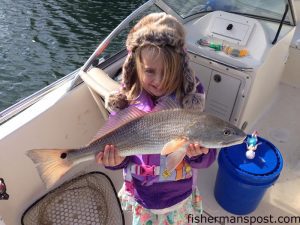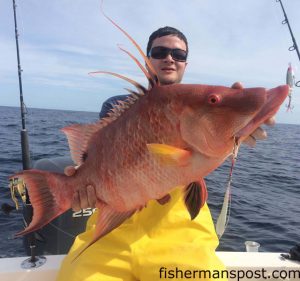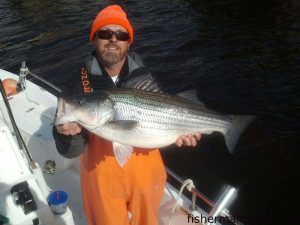Wrightsville Beach March 6, 2014

Charlie Francisco (age 6) with a slot red drum that struck cut shrimp near a Wrightsville Beach dock while she was fishing with her father Cameron.
Arlen, of Tex’s Tackle, reports that anglers are seeing some excellent blue water fishing off Wrightsville when the seas calm enough to run to the break. Trolling skirted ballyhoo and lures around the Steeples and Same Ol’ Hole recently has been producing action with wahoo and blackfin tuna.
Dropping vertical jigs to structure in the same areas, anglers are connecting with cobia, African pompano, amberjacks, and a variety of bottomfish.
Triggerfish, beeliners, hogfish, and more are feeding around bottom structure in the same areas and will pounce on bottom rigs baited with squid.
Closer to the beaches, big numbers of black sea bass are feeding around bottom structure from 50’ on out. Targeting areas in the 30+ mile range will lead anglers to the largest sea bass at present, and they’ll bite baited bottom rigs or small vertical jigs.
Some false albacore are feeding on the surface in the same range.

Capt. Arlen Ash, of Ultimate Reaction Sportfishing, with a hogfish that fell for a 4 oz. Blue Water Candy Roscoe Jig at some bottom structure along the break off Wrightsville Beach.
Surf casters are connecting with some red drum around area inlets and along the beachfront, primarily on artificial lures like soft plastics and spoons.
Red and black drum are schooling up around docks inshore, but they’re a bit tough to tempt to bite in the cold water. Working scented soft baits slowly across the bottom and dead-sticking shrimp are the best bets to fool the drum.
Rick, of Living Waters Guide Service, reports that there’s been some phenomenal vertical jigging along the break off Wrightsville, where anglers are connecting with blackfin tuna, amberjacks, African pompano, and a few cobia while working jigs in 150-250’ of water. Wahoo are feeding in the same areas and will fall for trolled baits and swimming plugs. A surprising number of dolphin have also been in the area for wintertime.
Bottom fishing in 130-150’ is producing excellent catches of triggerfish, vermillion snapper, hogfish, red porgies, and more. Squid will fool all the bottomfish.
Black sea bass, grunts, and more porgies are feeding around structure in the 25-40 mile range, where squid or small vertical jigs will produce results.
Anglers bottom fishing within 10 miles of the beach can find tautog feeding near wrecks and hard bottoms, and shrimp, crabs, and jigs will all appeal to the ‘togs.
Mike, of No Excuses Charters, reports that anglers have been seeing some large schools of red drum in the shallows from Topsail to Bald Head Island over the winter. The fish have been feeding most days despite the cold, and slowly working or dead-sticking Gulp baits or other soft plastics scented with Pro-Cure Super Gel is the way to tempt them to bite. Weightless to 1/8 oz. weedless hooks are a better choice than jigheads to work baits through the oysters and mossy algae on the bottom.
Some larger upper to over-slot reds are feeding around the Masonboro jetties, and 3/8 oz. jigheads paired with Gulp baits are the way to fool the reds in the deeper water.

Capt. Jamie Rushing, of Seagate Charters, with a 16.5 lb. striped bass that struck a soft plastic bait in the Cape Fear River.
Speckled trout are also still feeding in the area’s inshore waters, but anglers must release them right now as the fishery is closed until June 15th.
Outside the inlets, anglers can find plenty of black sea bass feeding on bottom structure starting a few miles offshore. Bottom rigs baited with squid or small vertical jigs will tempt bites from the bass, but anglers should be prepared to weed through some undersized fish in order to connect with some keepers.
All the area’s fishing opportunities should be improving in the coming weeks with the arrival of spring and warming water temperatures.
Jim, of Plan 9 Charters, reports that there’s been action with red drum in the surf around the area inlets, but it’s been a bit inconsistent. Metal spoons and soft plastic baits are both fooling the reds when they’re biting.
Black sea bass are feeding at bottom structure within a few miles of shore, but anglers will likely have to move out to the 20 mile range to find decent numbers of keepers.
Steve, of Johnnie Mercer’s Pier, reports that anglers are hooking a few dogfish while bottom fishing with a variety of baits from the pier. The action lately has been best in the late afternoon and evening hours.
The water is 51 degrees, and anglers should see some sea mullet, pufferfish, and other targets show up as it creeps up towards 60 as the spring wears on.





